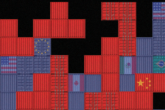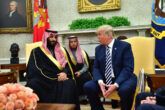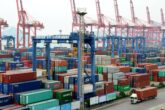February 08, 2021
Sanctions by the Numbers: Spotlight on North Korea
Since the beginning of the Korean War in 1950, the U.S. government has used a variety of coercive economic measures—ranging from total embargoes to economic sanctions—to combat the North Korean security threat. Over time, North Korea expanded its nuclear and ballistic weapons capabilities and began procuring funds for further weapon development through illicit financial activity such as money laundering, narcotrafficking, and cybercrime. In 2005, the U.S. government responded to this elevated threat with the first set of North Korea-specific economic sanctions, providing the groundwork for future U.S. and United Nations (U.N.) North Korean sanctions programs. In 2006, the United Nations Security Council passed Resolution 1718. This created the U.N. Security Council Sanctions Committee on North Korea, which is still active today.
Sanctions on North Korea by Program (Source: Historical data from 2009–2020 from the U.S. Department of the Treasury Office of Foreign Assets Control)
In recent years, however, U.S. sanctions regimes took a more comprehensive approach by targeting third-party actors and supportive agents, mostly from China and Russia, who continue to facilitate sanctions evasions and illicit financial activity to the benefit of North Korea’s dangerous weapons program. While President Barack Obama's administration pursued a policy of “strategic patience” on North Korea—rewarding good behavior with opportunities for engagement and punishing bad behavior, such as missile launches or nuclear tests, with increased sanctions—President Donald Trump’s administration adopted a more economically aggressive approach. Under four years of maximum pressure, Trump imposed the harshest sanctions regimes in history with North Korea as one of their main targets. However, Pyongyang has managed to avoid the full brunt of U.S. and U.N. counterproliferation measures with sanctions evasions assistance from overseas.
New Sanctions Designations on North Korea (Source: Historical data from 2009–2020 from the U.S. Department of the Treasury Office of Foreign Assets Control)
Along with Iran and Venezuela, North Korea is one of the most heavily sanctioned countries in the world. Following North Korea’s unprovoked attack and sinking of the Republic of Korea Ship (ROKS) Cheonan in 2010, President Obama issued Executive Order 13551, which created the first North Korea–specific sanctions program, DPRK. Near the end of the Obama presidency, North Korea conducted additional missile launches and cyberattacks targeting U.S. businesses and foreign financial institutions, including the 2014 Sony Pictures Entertainment hack and the 2016 Bangladesh Bank cyber heist. In response, the U.S. government rapidly sanctioned banks, businesses, and individuals outside North Korea—particularly in Russia and China—for illicit activity aiding the North’s nuclear weapons development program. Most notably, President Obama issued Executive Orders 13687 and 13722, which created two new North Korea–specific sanctions programs, DPRK2 and DPRK3, respectively. The former expanded previous sanctions targeting government assets and financial activity, while the latter added specific language to designate “significant activities undermining cybersecurity.” From its codification in 2016 to the present, the Office of Foreign Assets Control has targeted malicious North Korean cyber actors and entities only through the country-specific DPRK3 sanctions program and not CYBER2. Despite these efforts, North Korea continued to successfully expand its nuclear and ballistic missile capabilities during this time with illicit funds obtained through its sanctions evasions schemes, including cybercrime.
Sanctions on North Korea under President Donald Trump, 2017–2020 (Source: Historical data from 2009–2020 from the U.S. Department of the Treasury Office of Foreign Assets Control)
Under his maximum pressure campaign, President Donald Trump drastically increased and sustained heavy sanctions against North Korea from 2017 to 2020. In particular, he issued Executive Order 13810 to create an additional North Korea–specific sanctions authority, DPRK4, that targets illicit maritime and airborne trade, advanced technology imports and technical support, and party-led commercial activities. In 2018, Trump also threatened a preemptive strike against North Korea in response to their continued weapons development which significantly heightened tensions and global concern regarding a second Korean War. Throughout his presidency, Trump has levied the largest number of sustained sanctions against North Korea, but ultimately pulled back significantly after summit diplomacy with Kim Jong Un in 2018 and 2019.
DPRK-related Sanctions Outside North Korea (Source: Historical data from 2009–2020 from the U.S. Department of the Treasury Office of Foreign Assets Control)
In recent years, the U.S. government has designated numerous foreign entities facilitating illicit North Korean activity with particular prevalence in China and Russia. In 2020, the U.S. Treasury Department issued sanctions on Chinese and Russian shipping companies and vessels for conducting illicit ship-to-ship transfers of sanctioned materials with North Korea. In the same year, the Treasury also sanctioned several Chinese nationals linked to illicit North Korean cyber activity and professional money laundering schemes. There are many reasons as to why states and entities host and/or facilitate North Korean sanctions evasions, such as poor regulatory scrutiny and legal safeguards, high exploitation of existing crime networks, and willful blindness to illicit activity. Numerous U.N. reports and U.S. government analyses suggest that the latter represents the bulk of sanctions evasions conducted in Chinese and Russian jurisdictions.
Methodology
The following sanctions programs are included: NPWMD, DPRK, DPRK2, DPRK3, DPRK4, DPRK-NKSPEA, and CYBER2. In cases where an entity has its designation changed after its initial listing under a program, the date of its initial designation is counted instead of the date of its adjustment.
The United States has only made DPRK-NKSPEA designations in conjunction with DPRK3. To prevent overlap, the “Sanctions on North Korea by Program” and “Sanctions on North Korea under President Donald Trump (2017–2020)” graphs attributed those two designations to only DPRK-NKSPEA. Similarly, when the United States imposed a designation jointly under the DPRK2 and DPRK3 program tags for the first time in December 2020, it was counted as a single DPRK2 designation within the same graphs.
Learn More
The CNAS Sanctions by the Numbers series offers comprehensive analysis and graphical visualization of major patterns, changes, and developments in U.S. sanctions policy and economic statecraft. Members of the CNAS Energy, Economics, and Security Program collect and analyze data from publicly available government sources, such as the Treasury Department’s Office of Foreign Assets Control.

Sanctions by the Numbers
About this series The Sanctions by the Numbers newsletter and series offers comprehensive analysis and visualization of major patterns, changes, and developments in U.S. sanct...
Read MoreMore from CNAS
-
Sanctions by the Numbers: U.S. Sanctions Designations and Delistings, 2009–2019
The United States uses financial sanctions as a prominent tool of foreign policy. While this tool is used with increasing frequency and popularity, there is relatively limited...
By Johnpatrick Imperiale
-
Game Over?
The trade wargame suggests that sustained high tariffs could create leverage and urgency to spur action toward a productive restructuring of the international trade system....
By Emily Kilcrease & Geoffrey Gertz
-
Middle East Security / Energy, Economics & Security
Trump Inks $600 Bn Deal In Saudi Arabia | Musk, Blackrock CEO Flank Trump In Gulf VisitIn today's episode of India Global, U.S. President Donald Trump secured a $600 billion commitment from Saudi Arabia on Tuesday to invest in the United States. NDTV's Gaurie Dw...
By Daniel Silverberg
-
Energy, Economics & Security / Technology & National Security
Tariffs and Tech: An Uncertain RecipeHigher tariffs could prompt American cloud companies to shift more of their capital investments abroad....
By Pablo Chavez










